1936 Fordson Model Y gets ‘conservation’ restoration
Posted by Chris Graham on 24th July 2024
Mike Neale tells the fascinating story of a DIY, conservation-based restoration of a 1936 Fordson Model Y.

This 1936 Fordson Model Y pick-up is known as Charlie by its owners, Adrian Chalmers and Karl Grevatt.
The Ford Model Y 5cwt van was announced in 1932. The body was produced by Briggs Motor Bodies and supplied to the Dagenham factory, the first type having body code 121. It was timber framed, typically using beech or oak, clad in mild steel to the sides and rear, with a stretched canvas roof. The early “shortrad Model Y” vans had a straight front bumper and were fitted with running boards.
There was no passenger seat or driver’s door, the spare wheel being fixed to a mounting bracket on the offside running board where the driver’s door would have been, the driver getting in and out on the nearside by clambering over the gear-lever and handbrake. The nearside door was a long one as used on the 2-door Model Y saloon, extending almost to the leading edge of the rear wing. There were nine vent louvres in the bonnet sides. There were no windows in the back doors, meaning rearward vision wasn’t great and some owners had windows cut into the rear doors after purchase.
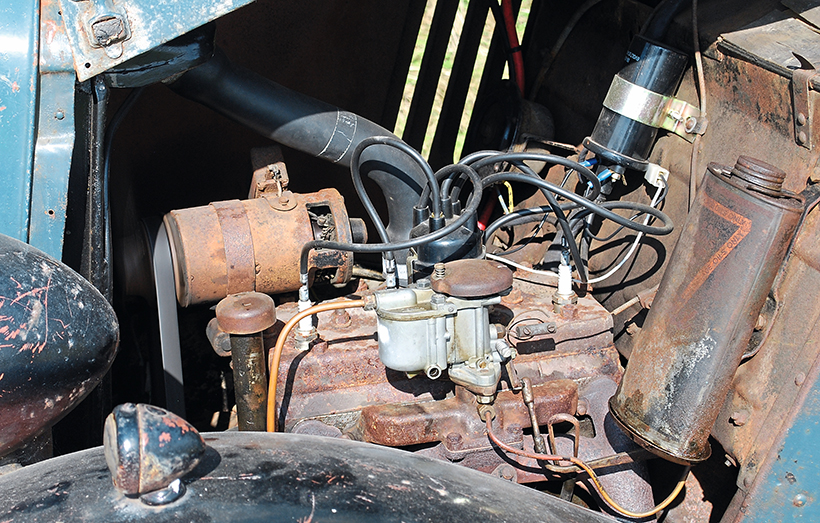
The 933cc sidevalve engine is believed to be the vehicle’s original unit.
From early 1933, a driver’s door was fitted, with the spare wheel mounted on it, both doors now being shorter, the same size as the four-door Model Y saloon. From June 1933, with Briggs body code 126, running boards were discontinued, requiring mudflaps to be fitted to the back of the front wings to reduce mud splashes onto the body sides.
From November 1933 a deeper grille was fitted, known as the “longrad Model Y”, the (by then optional) front bumper had a dip in the centre and there were now six louvres in the bonnet sides, these vans having body code 128. Both rear doors had three horizontal vent louvres added at the top. For 1935, vans finally had rear door windows whilst in October 1936 the spare wheel was moved to the nearside door.

Cab interior has been left largely original – once lost, patina like this cannot be recreated!
A few vans were converted privately to pickups. From late 1935, Dagenham Motors had a number converted by a coachbuilder straight from the Ford production line, removing the top part of the van body and strengthening the sides. The back of the cab was closed in with a new panel incorporating a rear window, thus providing much better rearward vision than in the vans, and a passenger seat was often fitted. A rectangular wooden frame was built onto the chassis to add strength to compensate for the removal of the van body. The spare wheel was mounted on this frame. A rear tailboard was fitted in place of the van doors.
The Model Y was replaced in November 1937 by the Ford Eight Model 7Y 5cwt van, built until 1946.
Conserving Charlie
This Fordson Model Y pick-up is known as Charlie by its owners, Adrian Chalmers and Karl Grevatt. First registered in Reading, Berkshire in 1936, but not much of its early history is known, so it is unclear if it was built as a van or pick-up. Later on, it was converted to its current form, which is thought to have been done for the vehicle to be used as a shooting brake on a country estate near Marlborough, probably as a beater’s van or to carry the guns. Note the additional lamp mounted on the roof to shine on to the birds plus the flaps in the canvas sides. There is also a map reading light behind the driver’s seat.
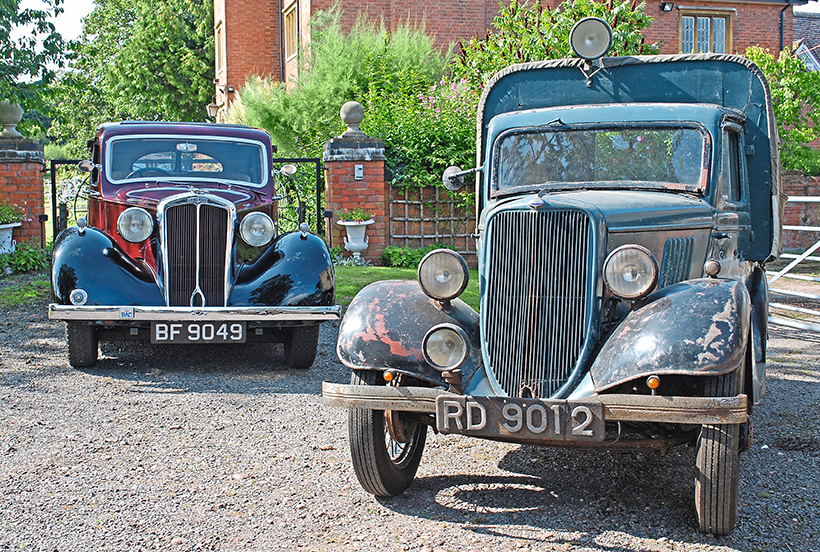
The squire’s car alongside the estate maintenance pick-up? Adrian and Karl have certainly caught the pre-wat bug and now also own a 1939 Lanchester.
“When it was restored, we found the underside was thick with dried-on cowpats!” laughs Adrian. The conversion work is believed to have been carried out by a Kent-based coachbuilder, although this is not certain, and it may have been done by the estate carpenter.
Adrian and Karl bought the Model Y in July 2015 from a garage proprietor in Marlborough who had been trying to buy it from the estate owner for some time. To begin with, the estate owner hadn’t wanted to sell, but eventually relented. It had been stored in the back of an old box van body for the previous 40 years, along with an old Rover. The garage owner had planned to restore it to advertise his business, but never got round to it, and put it up for sale again. Karl spotted it on a UK Barn Finds page on Facebook, which led him to the eBay advert.
“We decided to put a bid on it and ended up buying it sight unseen, against all advice,” recalls Karl. “People thought we were mad buying it. It’s very rare, but we didn’t really know what we were buying. We were after something pre-war to use as a promotional truck for Charlecote Mill. It is used and worn, you can see its age, so it was perfect for what we wanted.”

Body was designed and built to provide space for beaters on a bird shoot.
The Fordson goes to the mill on open days and is driven around the local area for fetes, car shows and local events as much as possible. It has also appeared at the NEC Classic Car Show.
“The mill dates from 1752, but there has been milling on the site for over 1,000 years – it’s in the Doomsday book,” Karl tells me. “It is the last working watermill in Warwickshire, still run as a commercial mill, one of a handful in the UK that still uses only natural power.”
They make wholemeal bread flour, natural white flour and chapati flour, producing around 80-100 tons per year using all traditional methods. It is powered by two 18ft. water wheels. Karl took it over in 2012.
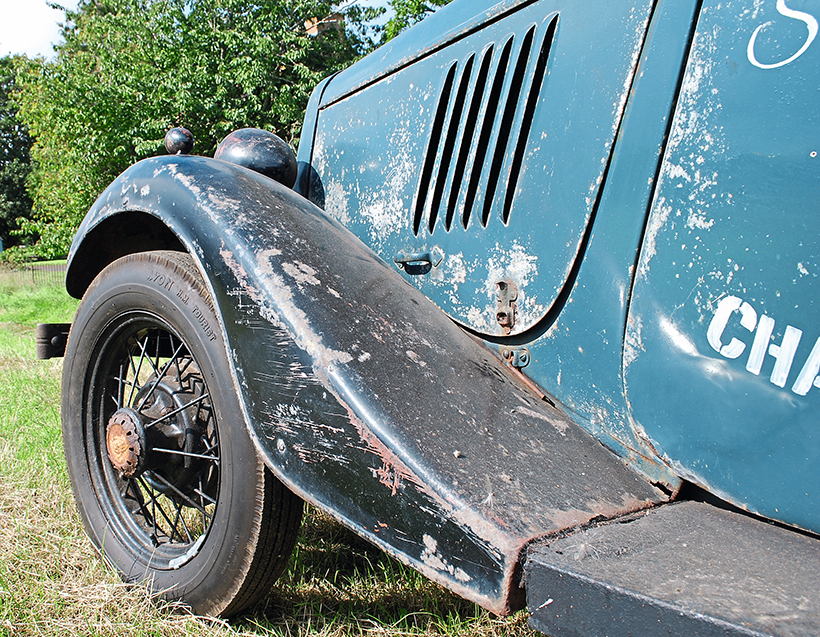
Six bonnet louvres indicate a post November 1933 Model Y.
The pickup sat in the barn for a couple of years, and Adrian realised that they weren’t going to get around to doing the work themselves. Adrian’s godmother’s husband was getting his Jaguar serviced at a garage in Snitterfield and mentioned that the owner had a few Fordsons. He in turn had a friend, Richard Clark, who carried out the restoration.
I say restoration, but the approach was more one of conservation. The body has been kept entirely as found. The signwriting on the doors was applied using chalk paint that would wash off without damaging the old paint. Some of the worst bits of the canvas back were repaired and new sections stitched in. “The running boards are home-made, it wouldn’t have had these originally,” notes Adrian. “The spare wheel was originally mounted on the door – the holes for this are still there but have been blocked up.”
The 8hp, four-cylinder, 933cc sidevalve engine is believed to be the pickup’s original. The milometer shows just 14,729 miles, possibly original.

Cab and driving position are somewhat bereft of creature comforts.
Richard stripped and rebuilt the engine, suspension and steering, replacing all perishable components, wear items and anything that might make the vehicle unsafe. He had the radiator re-cored. A new wiring loom was fitted and rear lights added, as, when bought, the Ford didn’t have any fitted! Indicators, brake lights and reflectors have also been added, plus electronic ignition which improved the running.
“Spares availability is good, through the Model Y Owners’ Club or Old Ford Spares, who have pretty much everything,” notes Adrian. “You cannot get a new windscreen surround, though, which is one thing we’d like to replace.”
Having driven a Ford Model Y saloon around central London a few times in the past, for which it was surprisingly suitable, I wondered what this commercial version was like on the road. “On its first run out, it bounced around like a clown car at the back,” laughs Adrian. “One of the new rear tyres wasn’t fitted properly and wasn’t seated fully into the rim on one side, making the tyre oval (the wheel was fine). We took it to be re-seated and then it drove fine.”
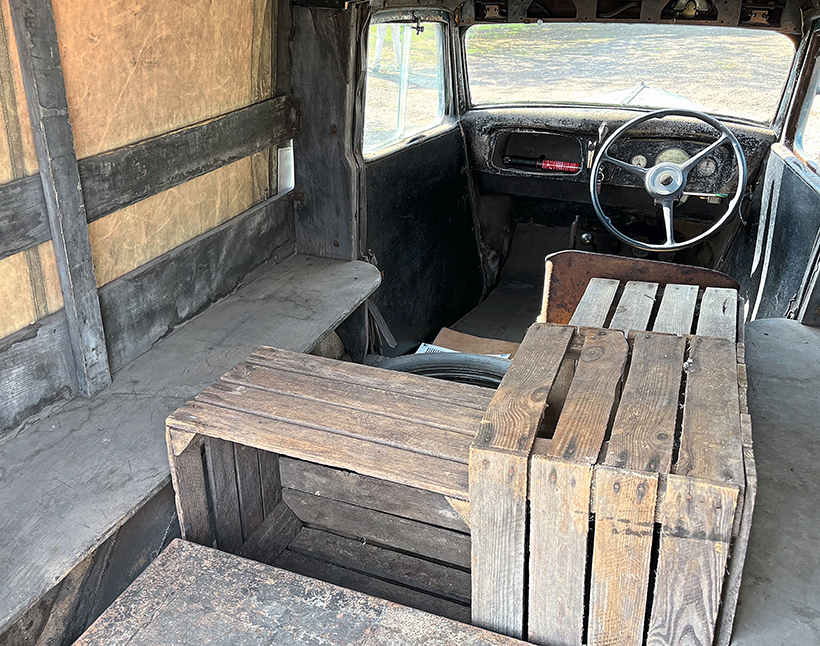
Under the canvas, the body has also been conserved rather than restored.
Karl added: “The furthest we’ve driven it was to Gaydon. It’s not pleasant to drive! The seat is right
on the floor, with no padding, so your legs are horizontal. You feel every lump and bump. With all that open space behind you, you hear all the road noise and, depending upon the wind, you get fumes blowing in through the back.”
“You wouldn’t take it on a motorway – even on a dual carriageway it was scary,” adds Adrian. “40mph is about the fastest it has been – maybe it once hit 45 downhill on the Fosse Way. It has the three-speed gearbox with synchromesh on second and third, but the synchro is quite crude, so you need to double de-clutch really. It has rod brakes, but it stops ok – they are quite effective.”

The “ancient” canvas tilt cover has only had minor repairs.
Adrian may fit an electric fuel pump, however, as it struggles a bit up hills, and you have to pull the choke out to get it to the top.
The vehicle is registered as a Ford but wears a Fordson badge on the front. Although the Fordson name was registered in 1933, it wasn’t until 1936 that Ford began using it on their commercial vehicles, so this is an early example to carry that badge. Over 29,000 commercial 5cwt variants of the Model Y were built, but very few survive today.
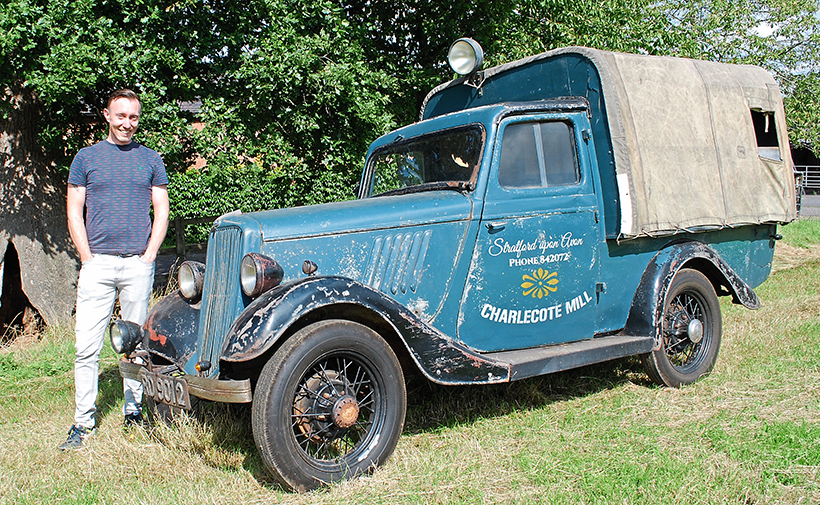
Owner Karl alongside the Fordson.
This was their first pre-war vehicle, but Adrian and Karl have clearly caught the bug as they have followed this by buying a lovely 1939 Lanchester. It looks like it could be the squire’s car next to the workman’s pick-up.
The Fordson is believed to be the only one like this, and most people have said to Karl and Adrian that they shouldn’t restore it any further. I’m inclined to agree.
This feature comes from the latest issue of Classic & Vintage Commercials, and you can get a money-saving subscription to this magazine simply by clicking HERE
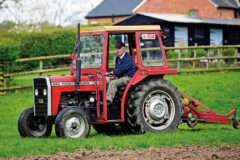
Previous Post
A faithful 1979 MF 240 workhorse

Next Post
1922 Burrell showman’s engine makes historic journey



